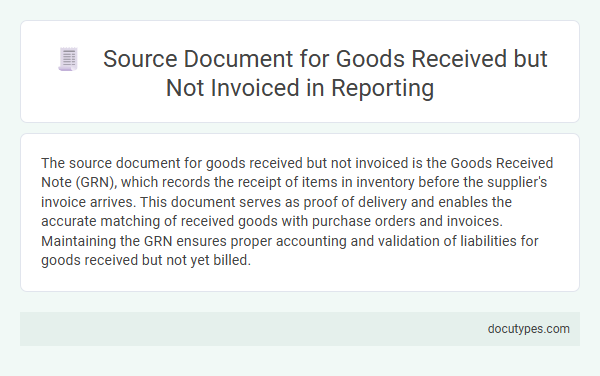The source document for goods received but not invoiced is the Goods Received Note (GRN), which records the receipt of items in inventory before the supplier's invoice arrives. This document serves as proof of delivery and enables the accurate matching of received goods with purchase orders and invoices. Maintaining the GRN ensures proper accounting and validation of liabilities for goods received but not yet billed.
Introduction to Goods Received but Not Invoiced (GRNI)
Goods Received but Not Invoiced (GRNI) represents inventory items that have been physically received but for which the corresponding supplier invoice has not yet been processed. This concept is crucial in accounting and inventory management to ensure accurate financial reporting.
The source document for GRNI is typically the Goods Received Note (GRN), which serves as proof that goods have arrived at your facility. The GRN details quantities and descriptions of received items, enabling accurate recording in the inventory system. Using this document helps to reconcile received goods against purchase orders and pending invoices effectively.
Definition and Importance of Source Documents
The source document for goods received but not invoiced is typically a Goods Received Note (GRN), which records the receipt of items into inventory before the supplier's invoice arrives. Source documents serve as critical proof of transactions, ensuring accurate accounting and inventory control. Properly maintained source documents help prevent discrepancies between received goods and invoiced amounts, supporting effective financial reporting and audit compliance.
Common Source Documents for GRNI Transactions
The source document for Goods Received but Not Invoiced (GRNI) is crucial for tracking inventory and financial records accurately. Common source documents provide necessary details for validating GRNI transactions.
- Goods Receipt Note (GRN) - Serves as proof of goods received, detailing quantities and conditions upon arrival.
- Purchase Order (PO) - Confirms the original order specifics and aids matching against received goods.
- Delivery Note - Records the shipment details from suppliers, helping verify physical receipt of goods.
You rely on these documents to ensure accurate recording and reconciliation of GRNI entries in your accounting system.
Role of GRNI in Financial Reporting
The source document for Goods Received but Not Invoiced (GRNI) is the Goods Receipt Note, which records the receipt of goods from suppliers without an accompanying invoice. GRNI plays a critical role in financial reporting by ensuring that received goods are accurately accounted for as liabilities, preventing the understatement of expenses. Your financial statements reflect a true picture of pending payables through proper GRNI management, supporting precise accrual accounting and audit compliance.
Documentation Workflow: From Receipt to Reporting
The source document for goods received but not invoiced is a key element in inventory management and accounts payable workflows. It bridges the gap between physical receipt of goods and financial reporting.
Understanding the documentation workflow from receipt to reporting ensures accuracy and controls in your financial processes.
- Goods Receipt Note (GRN) - This document confirms the physical receipt of goods and details quantities and conditions.
- Purchase Order (PO) - The PO serves as a reference that authorizes the purchase and specifies expected goods and pricing.
- Invoice Pending Register - This report tracks goods received that have not yet been invoiced, enabling timely reconciliation and reporting.
Key Data Elements in Source Documents
The source document for goods received but not invoiced is typically the Goods Received Note (GRN). This document serves as proof that goods have been physically received and inspected by your organization.
Key data elements in the GRN include the purchase order number, delivery date, item descriptions, quantities received, and supplier details. These elements ensure accurate matching with supplier invoices and maintain proper inventory records.
Internal Controls Over GRNI Source Documents
The source document for Goods Received but Not Invoiced (GRNI) typically includes the Goods Receipt Note (GRN) and delivery documentation. These records provide confirmation of the receipt of goods before the corresponding invoice has been processed.
Internal controls over GRNI source documents ensure accuracy and completeness in financial reporting. Controls include verification of physical receipt, approval workflows, and reconciliation with purchase orders to prevent discrepancies and potential fraud.
Challenges in Managing GRNI Documentation
What is the source document for goods received but not invoiced (GRNI)? A delivery note or goods receipt document acts as the primary source for GRNI entries. These documents confirm the receipt of goods while the invoicing process is still pending.
What challenges arise in managing GRNI documentation effectively? Incomplete or missing delivery notes disrupt accurate accounting and inventory tracking. Delays in matching purchase orders with received goods increase the risk of payment errors and financial discrepancies.
Impact of Incomplete Documentation on Reporting Accuracy
The source document for goods received but not invoiced typically includes goods received notes (GRNs) and delivery receipts that confirm the receipt of inventory before the invoice is processed. Accurate maintenance of these documents is essential for proper financial reporting and inventory management.
- Incomplete Documentation - Leads to discrepancies between received inventory and recorded financial liabilities, affecting accrual accuracy.
- Impact on Financial Reporting - Causes misstatements in accounts payable and inventory valuation, resulting in unreliable financial statements.
- Operational Consequences - Hinders timely reconciliation processes and delays in identifying discrepancies, impacting audit and compliance efforts.
What Is the Source Document for Goods Received but Not Invoiced? Infographic

